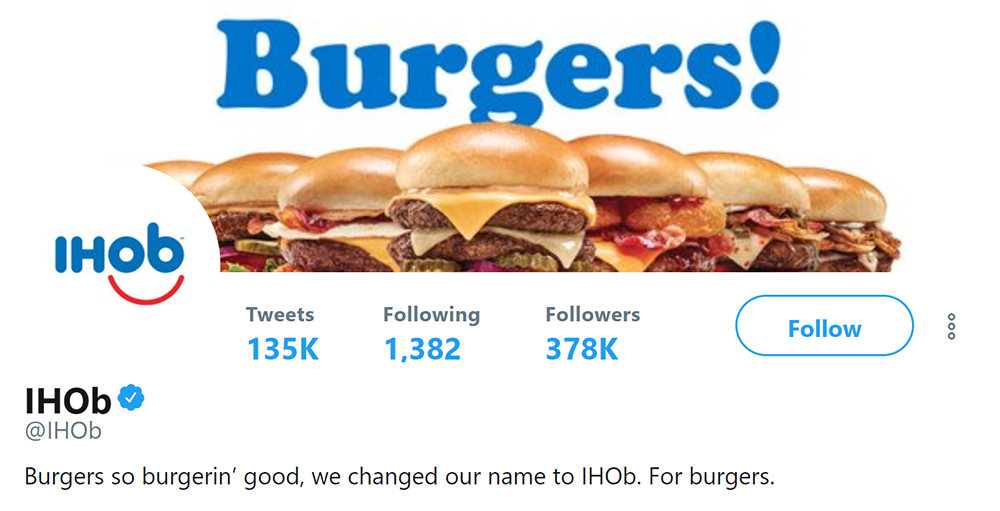The Trolling of IHOP (IHOB), and the Importance of Representative Consumer Insights
The recent marketing stunt by IHOB (aka IHOP), aimed at raising awareness of their pivot to serving burgers, has evoked a bevy of trolling on social media. At first glance, the trolling of IHOP (or is it IHOB?) by its competitors certainly provided the internet with a laugh at IHOP’s expense. But when taking a deep data dive into the world of burger-centric quick serve restaurants (QSRs), using nationally representative consumer datasets, it looks more and more like the joke will be on Burger King, Wendy’s, and Whataburger.

When looking at the entire burger-QSR vertical, it becomes clear that IHOP put some thought into expanding into the burger-QSR space, and for good reason. When breaking down the burger-QSR vertical by individual brand, we see that many of the larger burger QSR chains’ customers dine at IHOP. This includes some of the most popular burger QSR chains in the country, such as McDonalds, Carl’s Jr, Jack-In-The-Box, Sonic, Five Guys, In-N-Out, and more (see the chart below). These chains also include, of course, the three burger QSRs who chose to troll IHOP (aka IHOB) over their marketing ploy. In fact, in the past 30 days, 23% of Burger King customers have dined at IHOP and 26% of Wendy’s customers have as well, and Whataburger did not exactly come out unscathed, with 38% of their customers having visited IHOP.
Upon further analysis of IHOP’s customer base, a clear trend emerges – their love for burger QSRs. This clear affinity is highlighted by the fact that 90% of IHOP customers have visited a burger QSR in the last 30 days, including IHOP’s three primary social media critics – Burger King, Whataburger, and Wendy’s – into the equation. This trend is supported by a number of data points, among them being that a substantial 50% of IHOP’s customers have visited a Burger King, 44% have visited a Wendy’s, and a less shocking yet still sizable 16% of IHOP’s customers have visited Whataburger in the last 30 days. Not only are these data points quite noteworthy as is, but they are further strengthened when taking the mean visits to these three burger QSRs by IHOP customers in the last 30 days alone. IHOP customers who dined at these burger QSRs on average visited Whataburger 3.7 times, Wendy’s 3 times, and Burger King 2.6 times in the past month.

The clear trend of reciprocal affinity between burger QSR and IHOP customers continues to hold true when viewing the data from an index perspective. IHOP customers are 23% more likely to visit a burger QSR, and, when drilling down into the more popular burger QSRs, these indexes skyrocket. In fact, there is not a single burger QSR in the top 16 whose customer base doesn’t overindex significantly when cross-tabbed against visiting IHOP (see below), including Burger King (index of 153), Wendy’s (index of 169), and a staggering 250 index for Whataburger. These indexes (like all the aforementioned data points), shows a clear relationship between IHOP customers and burger QSRs – a relationship that IHOP is clearly trying to leverage for market share while their competitors are unwittingly aiding them in their task.
Upon digesting all these insights, it is hard to view the trolling of IHOP as a good idea for any burger QSR. In the fire that is IHOP’s brilliant publicity stunt, Burger King, Wendy’s, and Whataburger just added tons of fuel! By calling out IHOP’s marketing efforts, the burger QSRs ensured that any of their combined 5.4 million Twitter followers who were not aware of IHOP’s pivot to serving burgers are now aware and discussing it. Through this peculiar and comedic case, we see the tremendous importance that representative data plays in both marketing and business decisions.

The many applications for rich insights into both your customers and your competitor’s customers is essential to an informed marketing and business strategy. IHOP displayed the power of representative insights by deciding to highlight burgers and other lunch and dinner options at their locations, something their customers would clearly be amenable to.
This business decision, coupled with a brilliant social media marketing strategy to inform their customers and the greater American populace of their change, highlights the value of understanding your consumers on a personal level. This can be seen in the fact that IHOP customers are 31% more likely to have visited Twitter in the last 30 days, or that over 20% of people who have visited Twitter in the last 30 days have also eaten at an IHOP in that same time period. IHOP’s pivot towards a lunch/dinner-friendly menu and the marketing strategy behind it can be best described as a well-thought out and incredibly informed insights-driven business decision. IHOP took the time to understand their consumer’s food preferences and their social media habits, which they then utilized to identify potential areas for revenue and market share growth.
Inversely, If Burger King, Wendy’s, and Whataburger were in a completely different vertical, then their trolling of IHOP would have been a rather smart marketing move, akin to what New Balance did for Father’s Day (see below).

With 10% of IHOP customers owning New Balance sneakers and 16.4% of New balance sneaker owners eating at IHOP, New Balance’s jovial tweet to its 239,000 followers not only generated tons of impressions for New Balance (nearly 7,000 retweets), but more importantly, it does not harm their brand’s market share in any way! The decision to troll IHOP by its newly minted direct competitors (Burger King, Wendy’s, and Whataburger) is at best a sign of hubris and at worst a poor marketing decision that gave a tremendous amount of free promotion to a company that should be taken seriously as a competitor – a mistake that can be easily averted by having representative insights on your customers and your competition. Well played IHO(P)B!
Contact usfor more information on how Simmons' deep and representative consumer insights can help you understand your customers and those of your competition.



